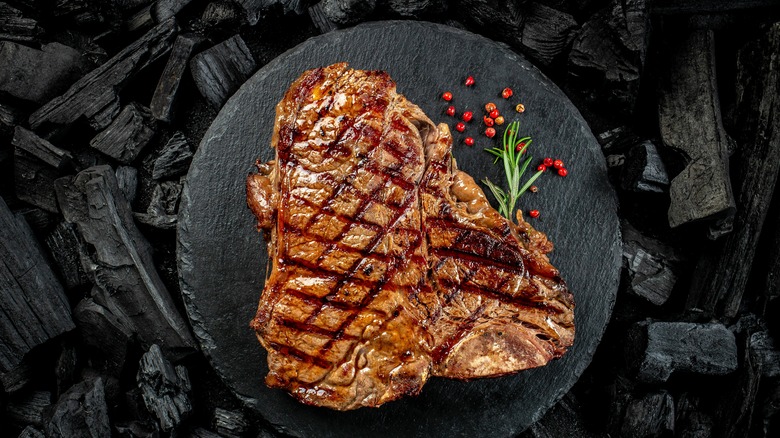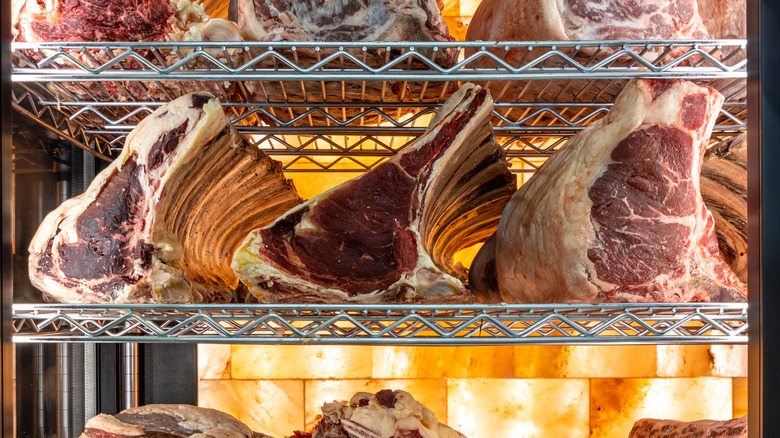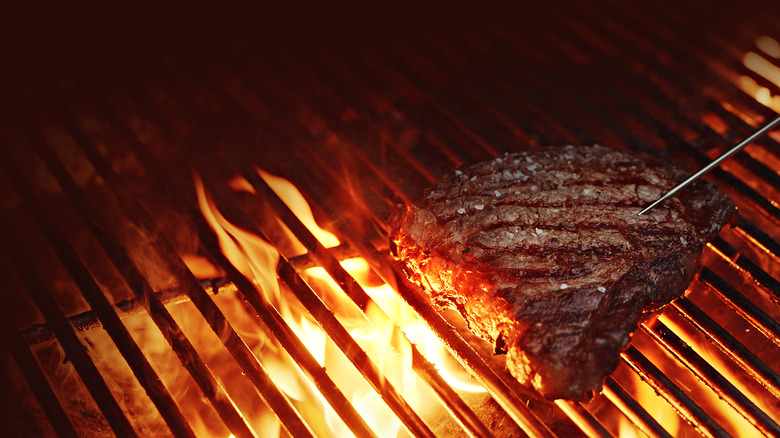The Reason Steak Tastes Different At A Restaurant
There are some foods that just seem to taste better at a restaurant. We can never seem to get the crust right when we make pizza at home, french fries often leave something to be desired (who has time to double-fry on a weeknight?), and ice cream made at home is great but we never remember to pre-freeze the ice cream maker insert. But one food that we've really noticed tastes different at restaurants is steak.
When a restaurant steak is cooked and brought to the table, we're usually greeted by a thick piece of meat with an impressive, deep-brown exterior, a shiny, butter-swathed top, and when cutting into it we're greeted by richly marbled, juicy meat cooked to our liking. The flavor always seems to be better, too, more savory and beefier than the steaks we buy at the grocery store. Well, it turns out that there is a legitimate reason for this difference. Not only are steak restaurants probably using a different grade of meat than what you buy at the store — they also often work with dry-aged beef, and they have higher-powered equipment in their kitchens to boot.
Restaurants use dry-aged meat
There are a few different reasons why steak cooked at a restaurant tastes different than steak cooked at home, and it starts with the meat. At the grocery store, the highest grade of beef you're likely to find is USDA Choice. Prime beef is primarily served at restaurants, has abundant marbling, and is made from young beef cattle. The marbling makes Prime steaks flavorful and more tender than the leaner Choice and Select cuts that you find at the grocery store.
On top of sourcing Prime meats, restaurants also often feature dry-aged steaks. Whether aged in-house or sourced from a meat purveyor, dry-aged beef, which is left to age in a temperature and humidity controlled environment, has additional layers of flavor compared to fresh beef. Dry aging beef results in moisture loss, which concentrates the flavor of the meat; it tenderizes the meat, thanks to the way enzymes within the steak break down muscle fibers and connective tissues. It also changes the flavor, thanks to reactions with different enzymes and bacteria, which deepen the savory flavors of the meat and bring out nutty and cheesy aromas and flavors (like the flavors that develop in blue cheese thanks to mold). It's more complex tasting than the steaks you get at a typical grocery store, and that's before they even cook the meat.
Restaurants use higher heat
Whether they're cooked on the grill, in a fry pan, or under the broiler, chances are restaurant steaks are being cooked at higher heat than what you use at home, thanks to some seriously powerful commercial kitchen equipment. A home oven temperature usually maxes out at 500-550 degrees Fahrenheit on the broiler setting, but many steakhouses used infrared and radiant broilers that are capable of reaching temperatures between 900 and 1,650 degrees Fahrenheit. The deep sear developed at these temperatures adds tons of flavor to your steak, thanks to the Maillard reaction.
This isn't to say you can't cook great steak at home. Chef Steve Doucakis told the Michelin Guide that he uses a cast iron pan to cook steak at home. "The cast iron will retain the heat really well," so the steak "can get a proper sear and caramelization." Chef Hilary Henderson of Wolfgang Puck's CUT Steakhouse told Robb Report that the key is heating the pan until the oil is smoking — "literally smoking right before it catches fire" — then adding the steak. It's good advice, considering that cooking at too low a temperature is the biggest mistake you make when cooking steak, according to Bobby Flay. Special order some dry-aged Prime steaks from a butcher and crank the heat, and you'll get as close as possible to making restaurant-worthy steak at home. But for all that effort, it starts to make the price tag at those fancy steakhouses seem a lot more reasonable.


